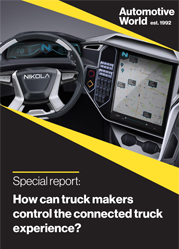Truck connectivity is an ongoing trend in the industry with a value potential that goes far beyond traditional telematics. The space is still characterized by the co-existence of many competing approaches by manufacturers and telematics services providers (TSPs). Truck makers need to develop clear strategies that position them well to capture their share of the value pool.
More than ‘tracking dots on a map’
The trucking industry has witnessed several technology waves that have transformed the industry. A few years back, innovation in the trucking space revolved around the key words of green, efficient and safe. Truck manufacturer visions centred around zero emission and zero accident trucking; truck emissions were successfully reduced; and advanced safety systems were made trucking safer. Today, this same vision drives investments in the next technology wave centred around Big Data and connected trucks. Connected solutions are creating significant value for industry participants via improved operations, increased safety and reduced cost. In parallel, industry leaders and ambitious start-ups are working on the ultimate version of safe, efficient trucks, i.e., fully autonomous trucking which is likely to hit the road this decade.
Connectivity touches all aspects of truck operations. The largest operating cost item for a fleet is driver cost, followed by fuel, equipment and finally maintenance. Almost all operating cost elements can be optimised by connectivity-enabled solutions. For example, driver cost can be reduced through driver coaching programs, fuel cost through fuel usage coaching, the equipment can be optimized through over the air (OTA) updates and predictive diagnostics can reduce maintenance cost. And even smaller cost elements like insurance can be impacted by connected solutions.
The largest operating cost item for a fleet is driver cost, followed by fuel, equipment and finally maintenance. Almost all operating cost elements can be optimised by connectivity-enabled solutions
Connectivity solutions have developed beyond traditional telematics solutions such as navigation and route optimization for quite some time, and encompass innovations such as predictive maintenance and emerging solutions like truck platooning and autonomous driving. These services are based on a set of enabling technologies like data processing and data transmission technologies, artificial intelligence as well as sensor technologies. As we have seen, there are efficiency gains and cost saving potentials, but connectivity also brings improved safety, reduced downtime and better service levels.
Towards a fully connected supply chain
The truck connectivity market has evolved from basic telematics in the past to fleet management solutions today and will develop towards a fully connected supply chain. With more and more solutions emerging, the truck connectivity market as a whole is transforming. In the past, telematics was mainly about asset tracking. Players used closed platforms built on their own proprietary software. Solutions would fall into one of two buckets: aftermarket retrofits and preinstalled truck manufacturer solutions.
Today, we talk about fleet management solutions that go beyond traditional telematics offerings. With more and more sensors being integrated into the vehicle, large amounts of data can be collected and transferred through faster data connections. Most players in the contemporary connectivity space have adopted open architectures and developed their own app ecosystems.
Connectivity solutions have developed beyond traditional telematics solutions such as navigation and route optimization for quite some time, and encompass innovations such as predictive maintenance and emerging solutions like truck platooning and autonomous driving
What will the future look like? We expect the transportation world to transform towards a fully connected supply chain, and truck connectivity will play a crucial role here. In this scenario, data will be shared across all players of the supply chain and new solutions beyond fleet management will emerge. Smart sensors will also integrate freight into this connected supply chain and make it part of the IoT. Next generation data transmission technology will play a vital role here as data volumes increase. 5G technology as a key enabler will support deeper and broader data access.
Different participation models
The truck connectivity space is still dominated by many competing solutions on the hardware and software side. Some truck manufacturers use proprietary telematics devices, while others use generic TSP systems. On the systems side, some truck manufacturers have proprietary connectivity solutions while others work with one or more TSPs. The strategies can differ again between OE and aftermarket solutions, leading to an overall large number of different permutations.
This chaos will likely start to clear up in the coming years. Most truck makers are already adopting open architecture strategies that allow third parties to install apps on their systems. This allows vehicle manufacturers to put most of the development responsibility on the shoulders of their suppliers. This promises to be a cost-efficient solution for them, since truck manufacturers do not need to spend resources on developing the code. More importantly, they don’t need to build up competencies in an area that is completely new to them. The downside is, however, that the truck manufacturer is ultimately responsible for the robustness of the entire system which can only be ensured through extensive testing and validation of the codes installed on the vehicles.
The truck connectivity space is still dominated by many competing solutions on the hardware and software side. Some truck manufacturers use proprietary telematics devices, while others use generic TSP systems
One functionality that vehicle manufacturers want to keep in-house across the board is remote diagnostics, which enables the health of the truck to be monitored from a remote location. All the different controllers in the vehicle, be it for the engine, transmission or brakes, can generate a vast range of different fault codes. Making this information available to a service location ahead of a workshop visit can enhance repair accuracy and efficiency, by reducing the average diagnostic time and by lowering the average time of repair. Truck manufacturers want to maintain control of remote diagnostics as this helps to protect their aftermarket business.
Unclear path to monetization
The value potential of truck connectivity is huge, but still players struggle with effectively monetizing it. It is difficult to provide an exact number for the market value of truck connectivity, but a simple calculation for the US market can illustrate how significant the potential is. As we have seen, connectivity can impact operating cost savings in multiple ways. Providers for the different solutions promise varying levels of saving potentials, but for simplicity we can assume saving levels of 5%-10% of operating cost. We estimate the annual operating cost for the heavy-duty truck fleet at around US$360bn. Considering the savings potential above, and the typical industry EBITDA multiple, we estimate the value pool at US$80-US$160bn. However, the US telematics market today is an order of magnitude smaller. This calculation may oversimplify things, but the comparison shows that we only see the tip of the iceberg of the whole potential. There is considerably more growth potential out there beyond traditional telematics.
A key question that needs to be answered before fully exploring this potential is how to monetize vehicle data. The automotive data value stream consists of distinct value creation processes ranging from data generation, on-board processing, transmission, off-board processing and service use. The value of data increases as we move along the value chain from data generation to processing and service development.
One functionality that vehicle manufacturers want to keep in-house across the board is remote diagnostics, which enables the health of the truck to be monitored from a remote location
The final step of the value chain is the actual usage of the service. In this step, monetization is most obvious, but other steps also provide monetization potential. Multiple business models exist to monetize data along the value chain. Besides selling data-enabled services, direct monetization of data is possible for the party that provides the data, such as the truck manufacturer or the owner of traffic data. Intermediaries like the telecommunication companies could sell supporting services such as data transmission.
All players in the connectivity ecosystem are trying to position themselves along the value chain to secure their share of the value pool. It is not yet clear how this will shake out. Vehicle manufacturers are typically in a strong position as they control the starting and end points of the value chain, i.e. the data generation and service usage. Component suppliers are also strong in data generation, but their challenge is that they lack a contact point with the end customer to monetize the data.
While the market value potential of truck connectivity solutions is significant, the industry is just starting to unlock the revenue potential of data. Different business models have emerged to monetize connected vehicle data, but their effectiveness still needs to be proven. Industry players, and particularly truck manufacturers, need to define where to focus their activities and how to develop a competitive advantage in the connected truck space.
About the authors: Dr Walter Rentzsch is a Principal and Dr. Wilfried G. Aulbur is a Senior Partner and Member Supervisory Board at Roland Berger




